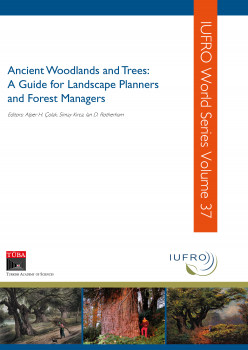Ancient and other trees of special interest: indicators of old growth biodiversity and heritage

Ancient and other trees of special interest: indicators of old growth biodiversity and heritage
Despite ancient trees being among the longest lived and some of the largest organisms on the earth, many UK ecologists are only beginning to catch up with understanding their significance to biodiversity and heritage. As trees age, usually from maturity onwards, they provide different habitats for a host of species from different Kingdoms that are not found on younger trees:
■ The heart- or ripe-wood decays and the trees become hollow,
■ Columns of dysfunctional sapwood develop,
■ Stag-headed dead wood occurs in the crown,
■ Decaying wood breaks off and falls to the ground,
■ The bark ages and its pH changes and
■ The roots age and hollow.
Tree populations are constantly aging and it is important that the habitats they provide are adequately replenished. One break in the timeline may result in extinction of species locally and even nationally.
The aging trees and their decaying wood habitat together with the associated, specialist decay and mycorrhizal fungi, lichens and invertebrate species is known as old growth. The Convention on Biological Diversity (CBD) defines old growth as stands in primary or secondary forests that have developed the structures and species normally associated with old primary woodland of that type that have sufficiently accumulated to act as a woodland ecosystem distinct from any younger age class (Alexander et al., 2003) (Figure 6.1).
Some Swedish research looked at the habitat requirements for hermit beetle Osmoderma eremita and found that a minimum area of 57 ha, containing 160 hollowing oak trees, is necessary to sustain this species but that for more demanding species the minimum area would be 954 ha, including 2,670 hollowing oaks.
For old growth to be fully expressed, a proportion of the trees must be allowed to grow full crowns which can retrench or ‘grow downwards’ in the latter stages of their long lives especially if the species are very light demanding such as pine or oak. An open crowned tree provides habitat that is not found in closed canopy forest such as large lower horizontal limbs in various light conditions depending on their orientation to the sun. Also, if too closely spaced, the aging trees are overtopped as their crowns retrench and are out competed especially in the presence of more shade tolerant trees especially hornbeam and beech. Old growth stands in the UK usually have a very wide diversity of tree and shrub species across the whole range of light demanding to shade tolerant. They also have a long history of grazing and look like parkland with scattered open crowned trees – the open forest hypothesis (Vera, 2000). In the UK the rich habitats in which old growth species have survived are usually not on the UK Ancient Woodland Inventories which represents woods comprising young trees in a coppice or plantation structure. In the UK, stands of old trees and their associated specialist species are commonly found in historic landscapes such as:
Remnants of mediaeval Royal Hunting Forests – places such as Windsor Great Park and Forest and Sherwood Forest with a wide diversity of native species principally oak, beech, birch, alder, sweet chestnut and lime plus shrubs providing nectar such as hawthorn standing in pastures and heath.
■ Caledonian forest – characteristically widely spaced granny pines with birch, alder, rowan and juniper standing in bilberry and moor.
■ Mediaeval deer parks – oak with many other species of tree with more recent non-native ancient and veteran trees of great value in grassland but in recent years sometimes converted to arable.
■ Ancient hedgerows, old commons and wood pastures of pollards of a wide variety of native species including oak, beech, ash, hornbeam, alder, holly, rowan.
Unfortunately, few sites retain the grazing conditions that are characteristic of the best old growth areas such as the New Forest where commoning still provides traditional mixed grazing by large herbivores - ponies, cattle and pigs as well as wild deer and rodents. Many old growth Forests are being lost to secondary tree establishment, especially of shade tolerant species, that are suffocating the old trees or have been subject to arable or grazing intensification with serious consequences for the trees. Old growth stands are not recognised on any inventory in the UK, even as wood pasture or parkland. Up until recent times parkland old growth has been labelled rather apologetically as a ‘cultural’ or rather man-made habitat and not a semi-natural one and its value has been severely diminished. Although at its best could be said to be the closest to the wildwood before man had a significant impact. By comparison with woodland, there is often for old growth sites documented historical evidence back to Anglo Saxon times i.e. hundreds of years prior to 1600 the cut-off year off date for the Ancient Woodland Inventory. The result is that in planning and landscape scale strategies it is all too easy for old growth or landscapes rich in ancient and veteran trees to be invisible to nonspecialists and overlooked.
